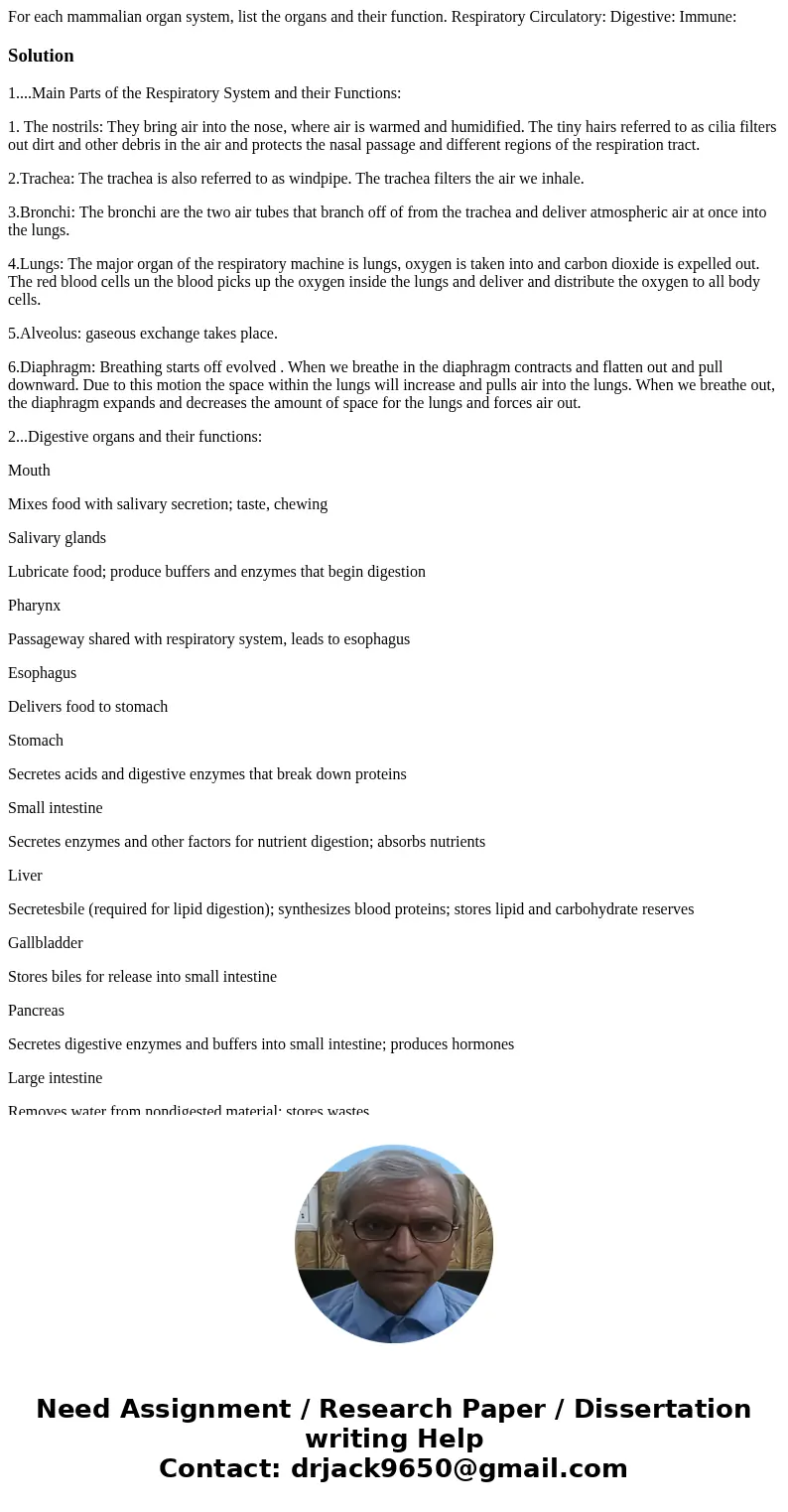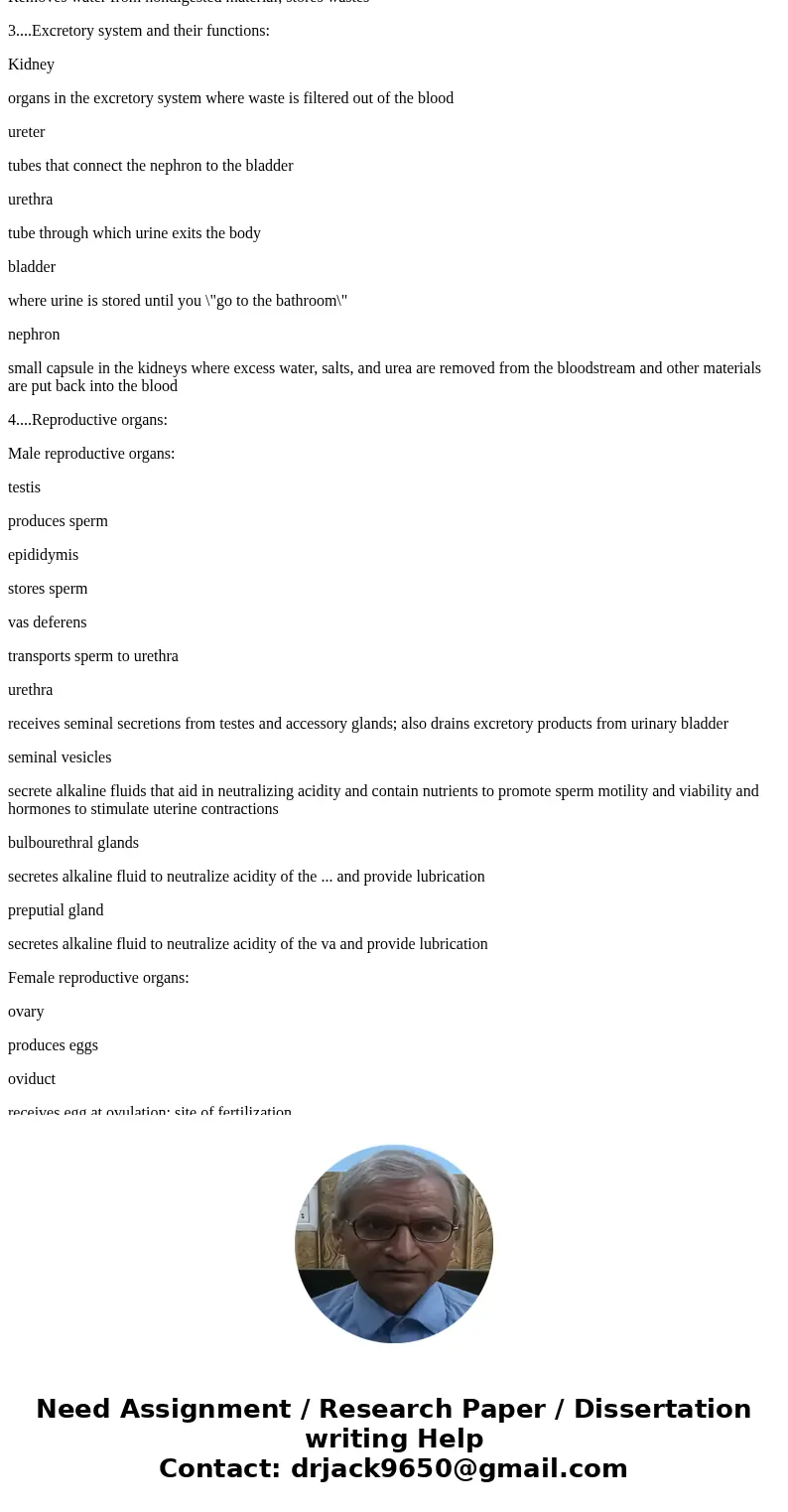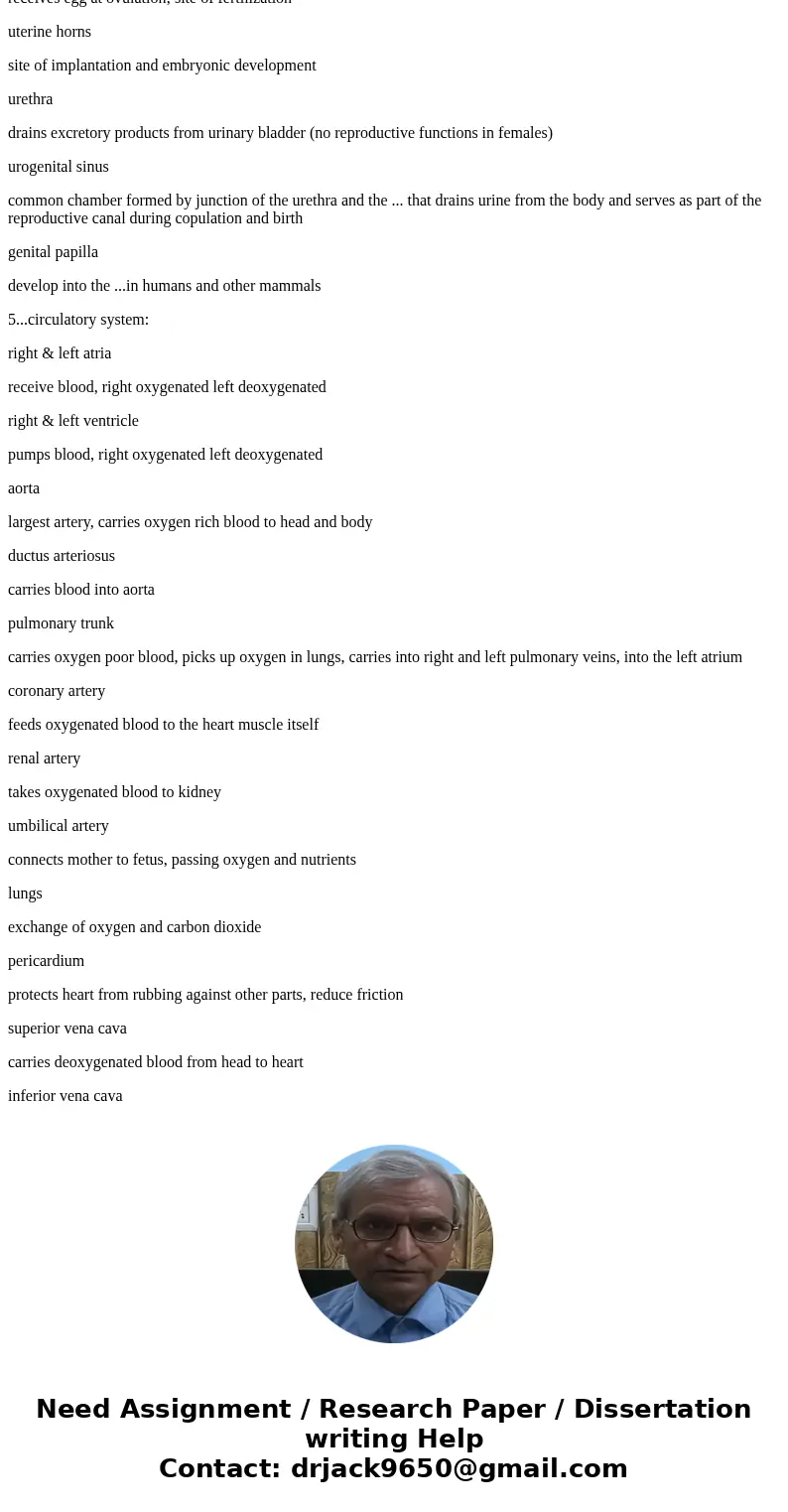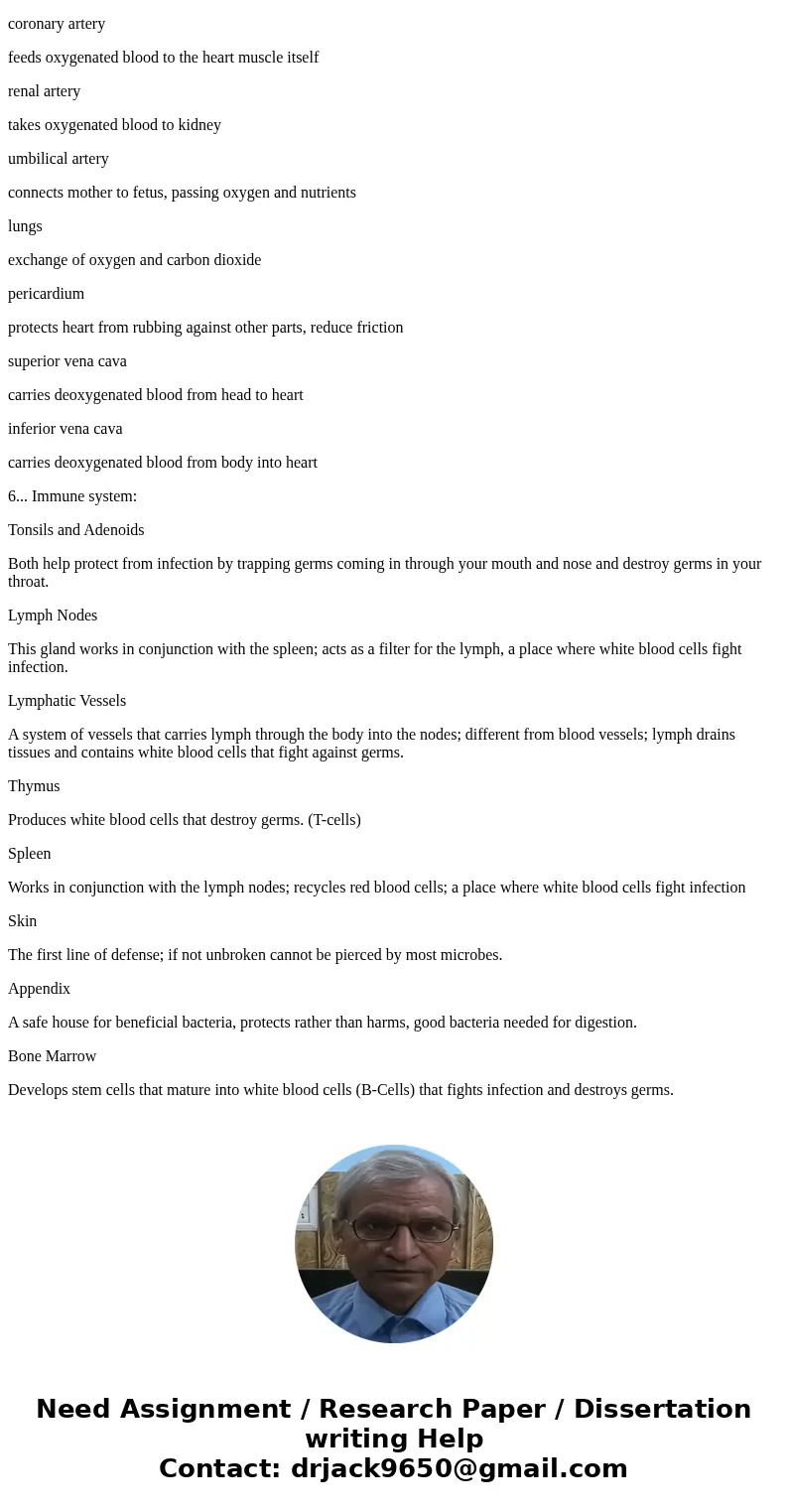For each mammalian organ system list the organs and their fu
Solution
1....Main Parts of the Respiratory System and their Functions:
1. The nostrils: They bring air into the nose, where air is warmed and humidified. The tiny hairs referred to as cilia filters out dirt and other debris in the air and protects the nasal passage and different regions of the respiration tract.
2.Trachea: The trachea is also referred to as windpipe. The trachea filters the air we inhale.
3.Bronchi: The bronchi are the two air tubes that branch off of from the trachea and deliver atmospheric air at once into the lungs.
4.Lungs: The major organ of the respiratory machine is lungs, oxygen is taken into and carbon dioxide is expelled out. The red blood cells un the blood picks up the oxygen inside the lungs and deliver and distribute the oxygen to all body cells.
5.Alveolus: gaseous exchange takes place.
6.Diaphragm: Breathing starts off evolved . When we breathe in the diaphragm contracts and flatten out and pull downward. Due to this motion the space within the lungs will increase and pulls air into the lungs. When we breathe out, the diaphragm expands and decreases the amount of space for the lungs and forces air out.
2...Digestive organs and their functions:
Mouth
Mixes food with salivary secretion; taste, chewing
Salivary glands
Lubricate food; produce buffers and enzymes that begin digestion
Pharynx
Passageway shared with respiratory system, leads to esophagus
Esophagus
Delivers food to stomach
Stomach
Secretes acids and digestive enzymes that break down proteins
Small intestine
Secretes enzymes and other factors for nutrient digestion; absorbs nutrients
Liver
Secretesbile (required for lipid digestion); synthesizes blood proteins; stores lipid and carbohydrate reserves
Gallbladder
Stores biles for release into small intestine
Pancreas
Secretes digestive enzymes and buffers into small intestine; produces hormones
Large intestine
Removes water from nondigested material; stores wastes
3....Excretory system and their functions:
Kidney
organs in the excretory system where waste is filtered out of the blood
ureter
tubes that connect the nephron to the bladder
urethra
tube through which urine exits the body
bladder
where urine is stored until you \"go to the bathroom\"
nephron
small capsule in the kidneys where excess water, salts, and urea are removed from the bloodstream and other materials are put back into the blood
4....Reproductive organs:
Male reproductive organs:
testis
produces sperm
epididymis
stores sperm
vas deferens
transports sperm to urethra
urethra
receives seminal secretions from testes and accessory glands; also drains excretory products from urinary bladder
seminal vesicles
secrete alkaline fluids that aid in neutralizing acidity and contain nutrients to promote sperm motility and viability and hormones to stimulate uterine contractions
bulbourethral glands
secretes alkaline fluid to neutralize acidity of the ... and provide lubrication
preputial gland
secretes alkaline fluid to neutralize acidity of the va and provide lubrication
Female reproductive organs:
ovary
produces eggs
oviduct
receives egg at ovulation; site of fertilization
uterine horns
site of implantation and embryonic development
urethra
drains excretory products from urinary bladder (no reproductive functions in females)
urogenital sinus
common chamber formed by junction of the urethra and the ... that drains urine from the body and serves as part of the reproductive canal during copulation and birth
genital papilla
develop into the ...in humans and other mammals
5...circulatory system:
right & left atria
receive blood, right oxygenated left deoxygenated
right & left ventricle
pumps blood, right oxygenated left deoxygenated
aorta
largest artery, carries oxygen rich blood to head and body
ductus arteriosus
carries blood into aorta
pulmonary trunk
carries oxygen poor blood, picks up oxygen in lungs, carries into right and left pulmonary veins, into the left atrium
coronary artery
feeds oxygenated blood to the heart muscle itself
renal artery
takes oxygenated blood to kidney
umbilical artery
connects mother to fetus, passing oxygen and nutrients
lungs
exchange of oxygen and carbon dioxide
pericardium
protects heart from rubbing against other parts, reduce friction
superior vena cava
carries deoxygenated blood from head to heart
inferior vena cava
carries deoxygenated blood from body into heart
6... Immune system:
Tonsils and Adenoids
Both help protect from infection by trapping germs coming in through your mouth and nose and destroy germs in your throat.
Lymph Nodes
This gland works in conjunction with the spleen; acts as a filter for the lymph, a place where white blood cells fight infection.
Lymphatic Vessels
A system of vessels that carries lymph through the body into the nodes; different from blood vessels; lymph drains tissues and contains white blood cells that fight against germs.
Thymus
Produces white blood cells that destroy germs. (T-cells)
Spleen
Works in conjunction with the lymph nodes; recycles red blood cells; a place where white blood cells fight infection
Skin
The first line of defense; if not unbroken cannot be pierced by most microbes.
Appendix
A safe house for beneficial bacteria, protects rather than harms, good bacteria needed for digestion.
Bone Marrow
Develops stem cells that mature into white blood cells (B-Cells) that fights infection and destroys germs.




 Homework Sourse
Homework Sourse